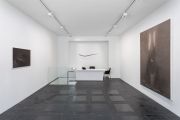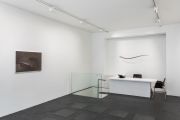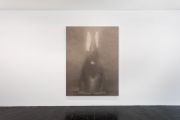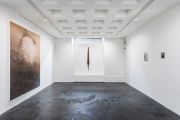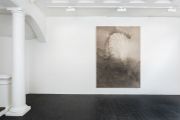Shao Fan
June 7 – July 27, 2024
Galerie Urs Meile Zurich
Opening:
Friday, June 7, 2024; 11am – 9pm
Press Release English
Galerie Urs Meile is delighted to announce the opening of the solo exhibition by acclaimed Chinese artist Shao Fan (b. 1964, Beijing, China) in its Zurich Gallery during Zurich Art Weekend 2024. The exhibition will showcase a selection of the artist’s latest ink paintings in different formats, alongside his equally celebrated sculptures. Shao Fan, as one of the most internationally recognized Chinese artists, occupies a distinguish position in the contemporary art scene. As much as admired for his monumental ink on paper portraits of animals, which are in spirit deeply rooted in Chinese culture, Shao Fan has never confined himself to the tradition of Chinese ink painting. In his recent works, Shao Fan presents a further evolution in his painting technique, transforming his internal state of mind into externalized expressions, paving the way for a unique visual experience and philosophical contemplation in ink painting.
During the epidemic, the village where Shao Fan’s studio is located was sealed off for a long period of time. With no idea of how long the lockdown would last, Shao Fan spent his days painting in the studio. Time became blurry, stretching infinitely during the repetitive laborious process. The objective conditions gave rise to a new approach to painting, marking a further technical trial for Shao Fan personally. It led to a continuous departure from the traditional Chinese ink painting, altering conventional artistic norms and visual experiences.
While Western oil painting focuses on form and color, traditional Chinese ink painting places greater emphasis on lines and ink. For Shao Fan, the interplay between line and form, ink and color, is worth pondering and reflecting on repeatedly. Unlike the rendering and covering techniques in oil
painting, ink painting relies heavily on lines without emphasizing perspective or background. Therefore, there is often ample blank space left on the painting. The ink, unlike oil paints, allows for minimal revision. Once the brush touches the paper, there is no turning back - it can’t be easily modified or covered again. Hence, the number of times a painting can be worked on is usually very limited, with completion in just a few attempts. Viewing Shao Fan’s ink paintings since early 2020, taking the series In
the Name of the Rabbit as an example, one would be astonished. The background in the ink paintings is completely covered with fine brushstrokes. This covering method differs from the broad strokes achieved
by a wide brush. The ink used isn’t a simple gray mixture of water and ink, but rather a meticulous technique resembling fur strokes, layering light ink bit by bit. This technique significantly alters the density of the painting. The resulting images become simultaneously dark and mysterious. Although
viewers can still discern the figures in the painting, while staring at them, they seem to dissolve and disperse, entering a dimension of coexistence. Shao Fan’s artistic alteration corresponds to the shift in his mindset, likening his painting process to the meticulous carving of jade, he understands the nuances of time as it slows down during his repetitive endeavors of creation.
In contrast to Shao Fan’s widely known large-scale ink portraits of hares and rabbits, the exhibition features two small ink rabbits on wood panels painted this year - Rabbit 0624, 2024 (ink on board, 33 x 24 cm) and Rabbit 0624, 2024 (ink on board, 33 x 24 cm). This fresh approach in experimenting
with materials – wooden panels instead of rice papers, a balanced mixture of glue and powders as the base on top of the board, results in unexpected artistic elements, such as minor crackling, which adds unexpectedly depth and character to the pieces. It seems to echo the texture of early Italian frescoes. The “smallness” of the works changes the relationship between the viewer and the seen. Standing in front of a rabbit larger than oneself might induce a subtle sense of oppression, while facing a particularly small
rabbit would evoke a feeling of adorableness, like a precious treasure one can play around with within a controlled space.
Though tigers had appeared in Shao Fan’s paintings before, Tiger Changing, 2023 (ink on ricepaper, 230 x 164 cm) merges the tiger with the artist’s imagination and symbolism of the tiger in the Book of Changes (I Ching)1. In his childhood, Shao Fan was told a story by a relative about encountering a leopard while hunting. At first not seeing the leopard’s figure, the relative only noticed its bright eyes, after which its body seemed to emerge suddenly from the surrounding scenery. Tiger Changing relates to this scenario.
The tiger’s patterns act as camouflage. In the painting, the tiger appears to blend among rocks and trees, with a beam of light from behind casting shadows, partially concealing its body. The captured moment is thus one of glimpses and ambiguity, a moment between “seeing” and “not seeing.” Furthermore, when studying the hexagrams of the I Ching, Shao Fan noted the hexagram “Ge,” representing change, whose statement takes the tiger as a metaphor - symbolizing a solemn and regulated transformation.
Similar to the tiger, Chinese cabbage holds special memories and sentimental significance for Shao Fan - Cabbage is basically the most common vegetable that appears on the table of every household
in winter in the north part of China. It evokes memories of warmth and familiarity, appearing particularly endearing to the artist. When painting Chinese cabbage, the leaves and stems can undergo many changes
in form, offering much to be admired.
In the exhibition also on display are Shao Fan’s two sculptural works, which are closely related to his paintings. The two threads of Shao Fan’s practices, while visually distinct, share a cohesive creative process and aesthetic logic. Ming Beard - 2006, No.5, 2006 (red sandal wood, 43 x 152 x 12 cm) represents that stroke, the stroke among countless strokes piled one on top of the other forming the rabbit in the painting. Its form evokes both a flowing beard and the armrest of a classic circle chair from Ming Dynasty
(A.D. 1368 to 1644). Ming Spine, No. 4, 2011 (huali wood, 19 x 166 x 6 cm) echoes animals featured in the exhibition. Both sculptures embody a graceful simplicity. Ming furniture is renowned for its clean lines and breathtakingly beautiful shapes. The craftsmanship found in both works further mirrors Ming techniques, utilizing joinery - a method where precisely carved components interlock seamlessly, eliminating the need for glue or nails.
Overall, the volume and precipitation of time in Shao Fan’s works imparts a tranquil power. The layering of brush and ink are like a densely woven net, creating a marvelous field around the viewer. In this intimate field, time flows through the gaps between strokes. Along where the artist’s brush points, we can explore another dimension of existence, and thus the painting itself becomes an ineffable place to dwell.
Shao Fan, Zi (Yu Han) was born in 1964 to a family of artists in Beijing and has lived there ever since. Since his childhood, he was trained by his parents in painting and by his grandmother in calligraphy. He has held many solo exhibitions and has repeatedly participated in important group exhibitions. Recent exhibitions include: In the Name of the Rabbit, Mirrored Gardens, Guangzhou, China (2023); The Ink of Yu Han, Galerie Urs Meile, Lucerne, Switzerland (2021); Shao Fan: Between Truth and Illusion, Het Noordbrabants Museum’s Hertogenbosch, Netherlands (2020); YOU, Ludwig Museum im Deutschherrenhaus, Koblenz, Germany (2018) and Suzhou Museum, Suzhou, China (2018); Recent Works, Galerie Urs Meile Beijing-Lucerne, Beijing, China (2018); Histoire naturelle, Kunstmuseum Luzern,
Lucerne, Switzerland (2018); Big Rabbit +, Galerie Urs Meile Beijing-Lucerne, Beijing, China (2016); Chinese Whispers, Kunstmuseum Bern and Zentrum Paul Klee, Bern, Switzerland (2016); A New Dynasty—Created
in China, ARoS Aarhus Art Museum, Aarhus, Denmark (2015); “Secret Signs” Chinese contemporary calligraphy exhibition, Deichtorhallen, Hamburg, Germany (2014); De la Chine aux Arts Décoratifs, Musée des Arts
Décoratifs, Paris, France (2014); St. Moritz Art Masters, St. Moritz, Switzerland (2013); Ink Art: Past as Present in Contemporary China, The Metropolitan Museum of Art, New York, USA (2013); Go Figure! Contemporary Chinese Portraiture, National Portrait Gallery, Canberra, Australia (2012); as well as the First Beijing International Design Triennial, National Museum of China, Beijing, China (2011). Numerous museums around the world, such as The Metropolitan Museum of Art in New York City, Peabody Museum of Salem in the United States, National Art Museum of China, Victoria and Albert Museum in England, Hong Kong’s M+ Museum, Fukuoka Art Museum in Japan, Royal Ontario Museum in Canada, Sigg Collection, Erlenmeyer Foundation in Switzerland, among others, have been collecting his works since 1988.
1 The I Ching or Yi Jing (Chinese: 易經), usually translated as the Book of Changes or Classic of Changes, is an ancient Chinese divination text that is among the oldest of the Chinese classics. The basic unit of the I Ching is the hexagram (卦 guà), a figure composed of six stacked horizontal lines (爻 yáo). Each line is either broken or unbroken. The received text of the I Ching contains all 64 possible hexagrams, along with the hexagram’s name (卦名 guàmíng), a short hexagram statement (彖 tuàn) and six line statements (爻辭 yáocí). The statements were used to determine the results of divination.
Downloads
Press Release (PDF English)
Press Release (PDF German)
Opening Hours
Wednesday to Friday, 11.00 am – 6.00 pm
Saturday, 11.00 am - 5.00 pm

